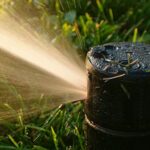This helpful buyer’s guide covers sprinkler control valves and timers. Learn about the different types of sprinkler valves and how to set up sprinkler timers.
Lawn and garden sprinkler systems have special valves that serve as gates for the water supply—they open or close to allow or shut off the water to the system. With most systems, several valves are involved, each controlling a different circuit, or series, or sprinkler heads.
Sprinkler valves may be controlled manually at the valve or remotely by a timer, connected by electrical wires to the valve. Most timers are designed to control several valves and operates the valves according to a preset program.
Types of Sprinkler Valves
Many types of sprinkler valves are available at hardware stores, garden supplies, home improvement centers, and online. They vary in size, material, and configuration.
Sprinkler valve sizes. For residential use, the most common sizes are 3/4-inch and 1-inch—that is, they fit those sizes of sprinkler pipes, so the size you choose will depend upon your system’s design. A 1-inch valve handles a heavier water flow than a 3/4-inch valve.
Sprinkler valve materials. You can buy high-impact plastic valves or brass valves. Though brass valves are far more durable than plastic, they are also far more expensive. Plastic valves are from $12 to $15 each; brass valves are upwards of $50 each.
Valve configurations. You can buy sprinkler valves individually or as manifolds, where two or more valves are grouped together in a single unit. Different kinds of sprinkler control valves are used in different climates.
In areas where pipes aren’t likely to freeze, anti-siphon valves are installed a foot above the circuit’s highest sprinkler and include a backflow preventer that prevents water in the pipes from contaminating the home’s water supply.
In colder areas, in-line control valves are placed underground in a protective box below the frostline; they require a separate backflow preventer.
In-line control valves are also used in areas where anti-siphon valves can’t be placed a foot above the highest sprinkler; these areas are generally where there are hills or slopes.
Sprinkler valves designed for manual use have a simple manual control on top. Most valves purchased, however, have solenoid that is intended to be wired to a timer.
Sprinkler Timers
Sprinkler timers, available online and in home improvement centers and hardware stores, run the gamut from simple to complex. You can buy individual battery-operated timers that control a single valve. Or you can buy high-tech plug-in timers that operate remotely to control many different circuits with complex watering schedules.
Simple timers. The simplest of mechanical timers attach to a hose bibb or hose Y; you simply set the dial to the amount of time you want it to water. However, since a mechanical timer does not use a power source, you have to set it manually every time you want to water. A battery-operated timer also attaches to the hose bibb or hose Y and will turn the system on and off automatically at scheduled times.
Some can be set for multiple-day intervals, specific days of the week, or several times a day. The model you choose will also determine whether it controls just one circuit or multiple circuits, each with its own schedule. Opt for one that will let you know when power’s running low—if the battery goes dead, you’ll lose what you’ve programmed in.
Multiple-circuit timers. For the greatest flexibility in automating a sprinkler system, a wall-mounted multiple-circuit timer that plugs into a 110V power outlet and is connected to the control valves with low-voltage insulated cable is the best choice. Some are made for mounting indoors; weather-tight models can be mounted outdoors.
There are a number of options when choosing an electronic timer. Some models run programs that turn each circuit on in a specified order, for the same amount of time, for the same number of times each week. More sophisticated models can run different programs on different circuits, allowing you to fine-tune the frequency and duration of each circuit for the different areas of your landscape.
Automatic timers typically control several circuits or “stations.” You can buy 4-, 6-, 8-, or 12-station timers.
While the more features a timer has the more expensive it will be, here are some features that may make the extra cost worth it to you:
• The ability to run separate programs on two valves at the same time (just make sure you have adequate water flow and pressure)
• Battery backup that maintains the clock and program information in case of a power outage.
• Expandable programming should you add circuits to your system in the future
• A rain sensor that monitors rainfall and turns off the system if it detects too much water, reducing waste and preventing a soggy lawn
• A remote control that allows you to reset programs without having to access a dark corner of the garage to make the changes
• A seasonal adjustment feature that allows you to adjust programs for the time of year and the likely temperatures and rainfall.












 Don Vandervort writes or edits every article at HomeTips. Don has:
Don Vandervort writes or edits every article at HomeTips. Don has:




